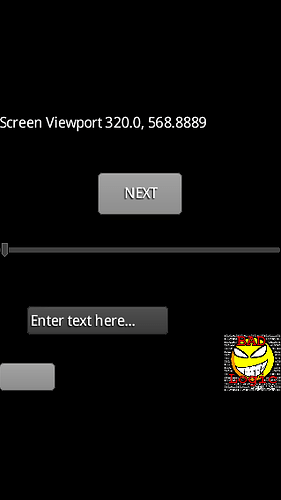https://github.com/Rickodesea/guil
This is a library designed to make it easier to size and position scene2d actors regardless of the viewport you are using.
Here is example code from the demo:
public class Game extends ApplicationAdapter {
public final static float width = 320;
public final static float height = 16 * width / 9;
WidgetManager wm;
Widget widget;
Widget textbutton;
Widget label, image, slider;
Widget textfield;
ViewportSwitch vps;
@Override
public void create () {
wm = new WidgetManager(width);
final Skin skin = new Skin(Gdx.files.internal("skin/default/uiskin.json"));
widget = new Widget(new Button(skin));
widget.pw = 0.2f;
widget.ph = 0.1f;
widget.bottom(0);
widget.left(0);
textbutton = new Widget(new TextButton("NEXT", skin));
textbutton.pw = 0.3f;
textbutton.ph = 0.15f;
textbutton.py = 0.2f;
textbutton.actor.addListener(new ChangeListener() {
@Override
public void changed(ChangeEvent event, Actor actor) {
vps.next();
wm.setViewport(vps.vp());
}
});
label = new Widget(new Label("GUIL demo", skin));
label.setSize(0.3f, 0.1f);
label.left(0);
label.top(0);
image = new Widget(new Image(new Texture("badlogic.jpg")));
image.right(0);
image.bottom(0);
image.setSize(0.2f, 0.2f);
slider = new Widget(new Slider(0, 10, 0.1f, false, skin));
slider.setDimension(0, 0, 1, 0.1f);
textfield = new Widget(new TextField("Enter text here...", skin));
textfield.setPosition(-0.15f, -0.25f);
textfield.setSize(0.5f, 0.1f);
wm.appendWidget(widget);
wm.appendWidget(textbutton);
wm.appendWidget(label);
wm.appendWidget(image);
wm.appendWidget(slider);
wm.appendWidget(textfield);
wm.setProcessor();
vps = new ViewportSwitch(width, height);
wm.setViewport(vps.vp());
}
@Override
public void render () {
Gdx.gl.glClearColor(0, 0, 0, 1);
Gdx.gl.glClear(GL20.GL_COLOR_BUFFER_BIT);
wm.render(Gdx.graphics.getDeltaTime());
final Label l = (Label)label.actor;
l.setText(vps.s()+ " " + vps.w + ", " + vps.h);
}
@Override
public void resize(int width, int height) {
wm.resize(width, height);
}
@Override
public void dispose () {
wm.dispose();
}
}
Try it and let me know what you think. Is this good or is it better to use libgdx’s actors directly ?

